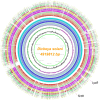Development and validation of genome-informed and multigene-based qPCR and LAMP assays for accurate detection of Dickeya solani: a critical quarantine pathogen threatening the potato industry
- PMID: 39660908
- PMCID: PMC11723575
- DOI: 10.1128/spectrum.00784-24
Development and validation of genome-informed and multigene-based qPCR and LAMP assays for accurate detection of Dickeya solani: a critical quarantine pathogen threatening the potato industry
Abstract
Dickeya solani one of the most aggressive pectinolytic phytopathogens, causes blackleg disease in potatoes, resulting in significant economic losses and adversely impacting one of the world's most important food crops. The diagnostics methods are critical in monitoring the latent infection for international trade of potato seed tubers and in implementation of control strategies. Our study employed a whole-genome comparative approach, identifying unique target gene loci (LysR and TetR family of transcriptional regulators gene regions) and designing loop-mediated isothermal amplification (LAMP) and a multi-gene-based multiplex TaqMan qPCR assays for specific detection and differentiation of D. solani. Both methods underwent meticulous validation with extensive inclusivity and exclusivity panels, exhibiting 100% accuracy and no false positives or negatives. The LAMP method demonstrated the detection limit of 100 fg and 1 CFU per reaction using pure genomic DNA and crude bacterial cell lysate, respectively. The qPCR detection limit was 1 pg, 100 fg and 10 fg with quadplex, triplex, and singleplex, respectively. None of the assays were impacted by any inhibitory or competitive effects after adding host DNA (in qPCR) or crude lysate (in LAMP). The assays proved robust and reproducible in detecting the target pathogen in infected samples, with the LAMP assay being field-deployable due to its simplicity and rapid results acquisition within approximately 9 min. The reproducibility was confirmed by performing the assay in two independent laboratories. These assays offer a robust, rapid, and reliable solution for routine testing, with applications in phytosanitary inspection, disease diagnosis, and epidemiological studies.IMPORTANCEDickeya solani, one of the most aggressive soft rot causing bacteria and a quarantine pathogen, poses a severe threat to food security by causing substantial economic losses to the potato industry. Accurate and timely detection of this bacterium is vital for monitoring latent infections, particularly for international trade of potato seed tubers, and for implementing effective control strategies. In this research, we have developed LAMP and multi-gene-based multiplex TaqMan qPCR assays for specific detection of D. solani. These assays, characterized by their precision, rapidity, and robustness, are crucial for distinguishing D. solani from related species. Offering unparalleled sensitivity and specificity, these assays are indispensable for phytosanitary inspection and epidemiological monitoring, providing a powerful tool enabling management of this threatening pathogen.
Keywords: Dickeya solani; blackleg; detection; diagnostics; isothermal amplification; potato; quarantine plant pathogens.
Conflict of interest statement
The authors declare no conflict of interest.
Figures





References
-
- Kado C, Dworkin M, Falkow S, Rosenberg E, Schleifer K, Stackebrandt E. 2006. Erwinia and related genera the prokaryotes, p 443–450. Springer, New York, NY.
-
- Adeolu M, Alnajar S, Naushad S, S Gupta R. 2016. Genome-based phylogeny and taxonomy of the 'Enterobacteriales': proposal for Enterobacterales ord. nov. divided into the families Enterobacteriaceae, Erwiniaceae fam. nov., Pectobacteriaceae fam. nov., Yersiniaceae fam. nov., Hafniaceae fam. nov., Morganellaceae fam. nov., and Budviciaceae fam. nov. Int J Syst Evol Microbiol 66:5575–5599. doi:10.1099/ijsem.0.001485 - DOI - PubMed
-
- Lisicka W, Fikowicz-Krosko J, Jafra S, Narajczyk M, Czaplewska P, Czajkowski R. 2018. Oxygen availability influences expression of Dickeya solani genes associated with virulence in potato (Solanum tuberosum L.) and chicory (Cichorium intybus L.). Front Plant Sci 9:374. doi:10.3389/fpls.2018.00374 - DOI - PMC - PubMed
-
- Agrios GN. 2006. Bacterial soft rots. 5th ed. Academic Press, San Diego.
-
- Perombelon MCM, Kelman A. 1980. Ecology of the soft rot Erwinias. Annu Rev Phytopathol 18:361–387. doi:10.1146/annurev.py.18.090180.002045 - DOI
Publication types
MeSH terms
Substances
Supplementary concepts
Grants and funding
LinkOut - more resources
Full Text Sources

